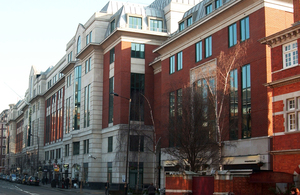Huge increase in commuter trains possible with HS2 says Hammond
More services available with high speed rail says Transport Secretary.

Many towns and cities could benefit from a huge rise in direct trains to London once a new high speed rail network is built, Transport Secretary Philip Hammond told business and civic leaders from across London and the South East today (1 April 2011).
With intercity services transferring to a new high speed line, significant extra space would become available on the existing network, meaning towns such as Milton Keynes, Northampton and Rugby could become much better connected to London.
The Department for Transport and HS2 Ltd have already established that an extra 11 services could be run on the West Coast Main Line every hour once the first phase of HS2 is built from London to the West Midlands. Completion of the second phase to Manchester and Leeds could deliver similar improvements for commuter locations on the East Coast Main Line such as Luton, Bedford and Stevenage.
Mr Hammond also announced that an industry-led group, headed by Passenger Focus and Network Rail, would be established to investigate how best to use the extra capacity.
Transport Secretary, Philip Hammond said:
Our proposed new high speed rail network would free up a huge amount of space on the current railways for more trains to operate. Building a whole new line would create scope for people who live on the current lines to have more frequent services that are less crowded - I would also hope that this additional competition could mean cheaper fares as well.
The reality is that many of our current trains are full and too many people have to stand - we desperately need the extra trains and capacity that a new high speed rail network would bring.
By bringing in the expertise of Passenger Focus and Network Rail at this early stage in the process, we can ensure that best possible use would be made of this new capacity, and I would like to thank them in advance for their work on this very important project.
The Department for Transport estimates the cost of the complete ‘Y’ shaped high speed network at £32 billion and expects it to generate economic benefits of around £44 billion and fare revenues of around £27 billion over a 60-year period.
The proposed network would be delivered in two phases - the first a line from London to the West Midlands and linked to the HS1 line to the Channel Tunnel, and the second the onward legs to Manchester and Leeds. The second phase would also include a direct link to Heathrow, bringing Sheffield and Leeds within an hour and a quarter of the country’s major hub airport.
The government is currently holding a public consultation on its proposals for high speed rail which runs until 29th July 2011.
Further information
Economic case
The cost of constructing a Y shaped network linking London, Birmingham, Manchester and Leeds, as well as the Channel Tunnel and Heathrow, is estimated to be £32 billion (in 2009 prices).
Over a 60-year period, HS2 Ltd’s analysis estimates that a national high speed rail network would generate benefits with a net present value of £43.7 billion. The net present cost to Government over the same period of building and operating the line would be £17.1 billion (calculated as total capital and operating costs of £44.3 billion less fares revenues of £27.2 billion).
On this basis, the government’s assessment is that the proposed network would have a benefit:cost ratio (BCR) of 2.6. The basis on which this BCR has been calculated is explained in more detail in the ‘Economic Case for HS2’, which is available on the consultation website. However, it does not include the significant strategic benefits relating to high speed rail’s potential for supporting: job creation, regeneration and long-term economic growth.
Consultation Details
The consultation on the government’s high speed rail proposals runs until 29 July.
A full suite of detailed supporting documents, including the economic case for high speed rail and a full Appraisal of Sustainability is also available on the website.
In the coming months, roadshows will be held along the proposed London-West Midlands line of route. You can see the full timetable of events on the consultation website.
The government’s proposed route
The government’s proposed network would be built in phases. Phase 1 would comprise an initial London-Birmingham line including a direct link to High Speed One (HS1). This would run from a rebuilt Euston station to a new Birmingham City Centre station at Curzon Street. A Crossrail interchange station would be built at Old Oak Common in West London, providing direct connections to: the West End, City and Docklands via Crossrail; to the South West and Wales via the Great Western Main Line; and to Heathrow via the Heathrow Express.
A second interchange station would be constructed where the line of the route passes the National Exhibition Centre and Birmingham Airport close to Junction 6 of the M42. It would offer direct links to Birmingham Airport, the National Exhibition Centre and the M6 and M42. A direct link to HS1 would be provided in tunnel from Old Oak Common to the existing North London Line, from where existing infrastructure can be used to reach the HS1 line north of St Pancras.
Phase 2 would see the new high speed line running on to Manchester and separately to Leeds. HS2 Ltd is currently engaged in detailed planning work for options for these routes, including stations in the East Midlands and South Yorkshire, as well as for a spur link to Heathrow. Connections on to the existing West and East Coast main lines would also be included, allowing direct high speed train services to be operated to cities including Glasgow, Edinburgh, Newcastle and Liverpool. Further consideration will also be given to extending the network subsequently to these and other major destinations.
Rail and major projects media enquiries
Media enquiries 0300 7777878
Switchboard 0300 330 3000